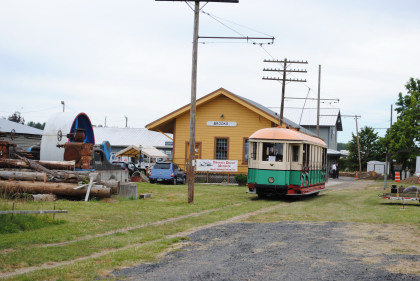
Today was the last day of the NRHS convention and featured Southern Pacific 4449 leading an excursion from Tacoma to Portland. Chris was going to ride this and Bob and I would do a bit of chasing, meet him in Portland then drive out to Brooks to visit the Oregon Electric Railway Museum.
The three of us drove to Tacoma and while waiting for the train, I saw Peter Lofthouse and his wife Norma. He was a colleague of mine who worked in another department at the British Columbia Ministry of Municipal Affairs when I lived in Victoria, and has been a steam enthusiast for many years. We had a nice chat then once the train arrived, our first destination was Steilacoom.
Southern Pacific 4-8-4 4449 leading the southbound NRHS convention train on a glorious Sunday morning through Steilacoom. How I would have liked to be on board, although I did enjoy seeing the train go by at speed with Cormorant Passage behind.
We continued south on I-5 and Chris kept us up-to-date on the train's location. It stopped at Centralia which allowed for catching it near Castle Rock, as the tracks are in the middle of I-5. There was not really anywhere else to catch the train and we were just too late arriving in Vancouver.
Southern Pacific 4449 at Portland Union Station with Amtrak F40 90278 beside. After meeting Chris in the Metropolitan Lounge, the three of us drove out to Brooks.
Oregon Electric Railway MuseumThe Oregon Electric Railway Museum is an operating trolley museum, featuring trolleys and other electric railway equipment from the West Coast as well as from around the world. Our railway equipment collection dates from the 1890's through 1977. The Oregon Electric Railway Historical Society was founded in 1957 and first established a trolley museum (Trolley Park) in Glenwood, about 40 miles west of Portland, along Highway 6 in 1959. The first operation of streetcars occurred in 1963 and regular oprations in 1966. It was built on the site of a former steam logging railroad and the OERHS re-equipped the former sawmill building of the Consolidated Timber Company as a four-track carbarn. The museum property occupied about twenty-six acres and trolley cars were able to operate on a 1.7-mile line. Operation at the Glenwood site ended in autumn 1995 when the museum moved to the grounds of Powerland Heritage Park in Brooks in 1995 and opened there a year later. The museum consists of about one mile of mainline track with overhead wire with a four-track carbarn to store the international collection of streetcars.
My ticket for the tram ride.
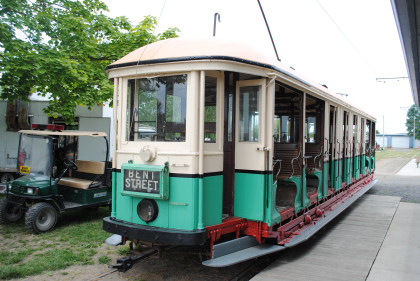
Oregon Electric Railway Museum's open car 1187, built 1912 for Sydney, Australia. The crossbench seating with both open and enclosed sections can fit 80 passengers. They were affectionately known as "toastracks". Car 1187 was shipped to the museum from Australia in 1959 via boat. It has been one of the museum's main operating cars since its arrival and was the first streetcar to operate in Brooks.
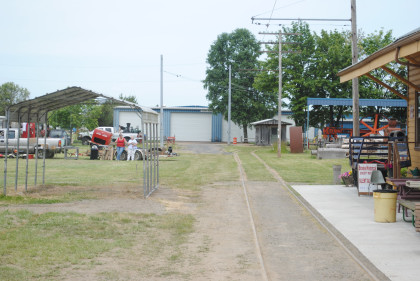
Once a brief safety talk had been given, we were off and departed the station area.

Approaching the first curve.
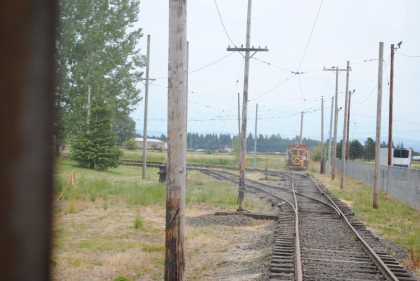
The track on the left is the lead to the shop.
Samtrak 25 ton switcher 2501 (ex. Samuels Steel, exx. Portland Public Docks LDE-1, nee U.S. Maritime Commission L-060-3). It was built in 1942 and Richard Samuels purchased it in 1992 for use on his Samtrak tourist train. When that ended, he donated it to the museum. Much later, in 2018, it was purchased by the Oregon Coast Scenic Railroad. The other 25 ton switcher is of unknown heritage.
Missoula Street Railway 35 ton freight motor 351 built in 1903.
Anaconda Copper 25 ton freight motor 254.
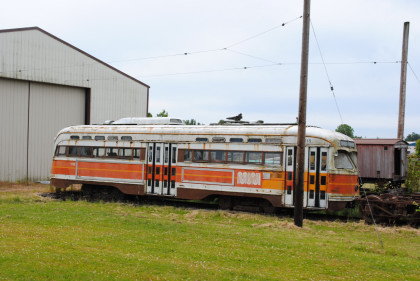
MUNI PCC car 118 from San Francisco.
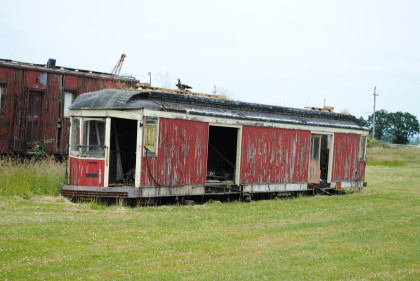
Mt. Hood Railway Interurban Express 1191 built in 1911.
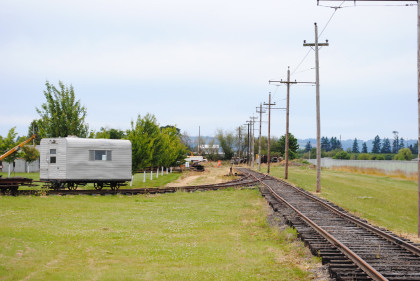
The trolley starts down the northern tangent track.
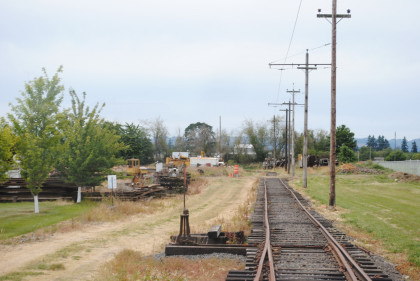
Looking forward as we continue our journey.
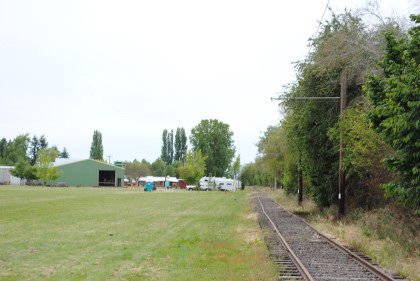
A view down the western tangent track.
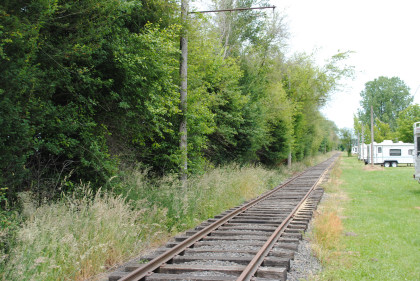
Approaching the end of the line.
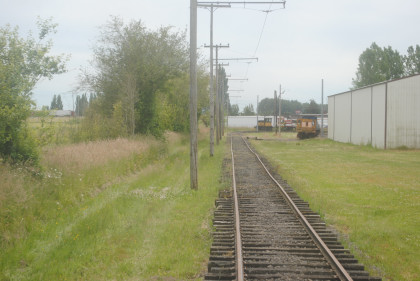
Heading back north on the western tangent track. Upon return to the boarding area, we detrained and started to explore the displays in more detail.
A slow speeder that can only travel at six miles per hour.
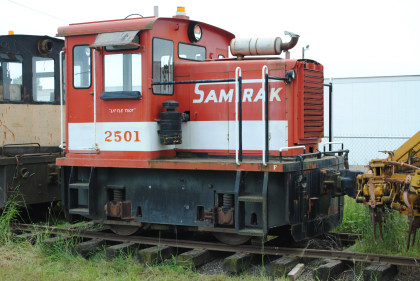
Samtrak 25 ton switcher 2501 (ex. Samuels Steel, exx. Portland Public Docks LDE-1, nee U.S. Maritime Commission L-060-3). It was built in 1942 and Richard Samuels purchased it in 1992 for use on his Samtrak tourist train. When that ended, he donated it to the museum. Much later, in 2018, it was purchased by the Oregon Coast Scenic Railroad.
San Francisco Muni PCC car 1159 (nee St. Louis Public Service 1726), one of two former PCC cars the museum owns.
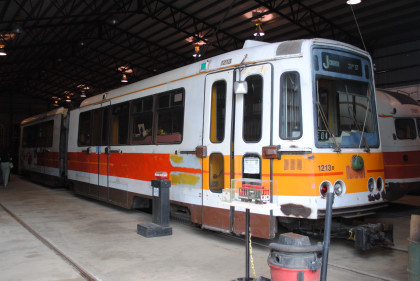
San Francisco Boeing Vertol Light Rail Vehicle (LRV) 1213. Boeing Vertol was the helicopter division of Boeing. These cars turned out to be overly complicated for a streetcar which led to their early retirement in 2001. These LRV's replaced the MUNI PCCs. 1213 was originally built as 1221 for demonstration purposes and is one of only 2 Boeing LRVs to ever have trolley poles. In regular service it used pantographs.
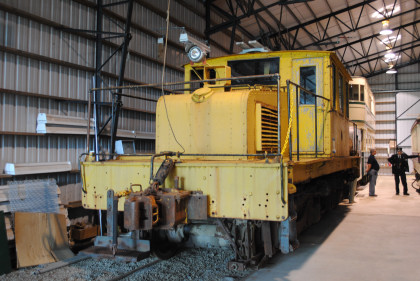
Anaconda Copper 25 ton freight motor 254.
Snow sweeper built by McGuire Car Company in 1899 for East Railway.
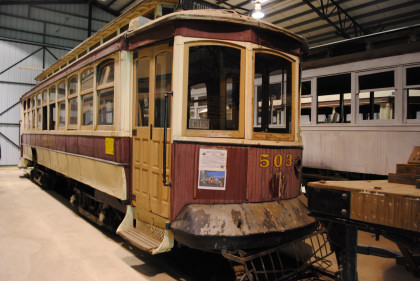
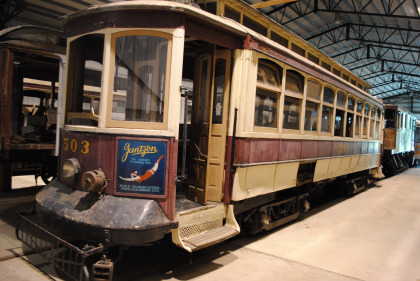
Council Crest Streetcar 503 built in 1904 by J.G. Brill for the Portland Street Railway. It was one of ten cars built that year for Portland Railway Co and the museum has two of this class of cars. The street railways of Portland ran on narrow gauge tracks and 503 currently has standard gauge trucks, a necessity for it to run at the museum. This car operated in San Francisco during the 1980's streetcar festivals while the cable cars were shut down.
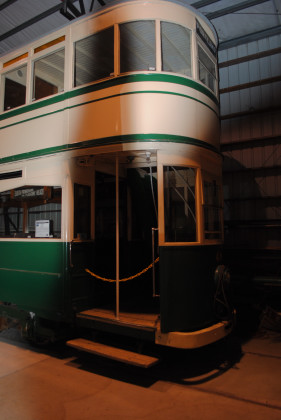
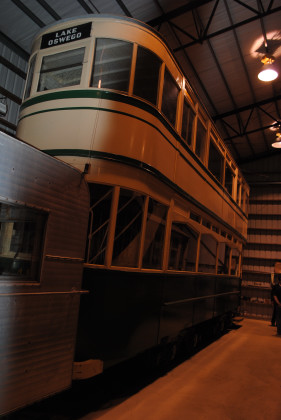
Blackpool double-deck tram 48 built in 1928 from Blackpool, England. It is the only city in England that never stopped operating trams. This car is notable as it was the last tram to operate out of the Morton Depot in 1960. In 1962, the tram was shipped to the United States and trucked to their former museum at Glenwood. It operated for several years on the Willamette Shore Trolley until 2004 when it was moved to Brooks.
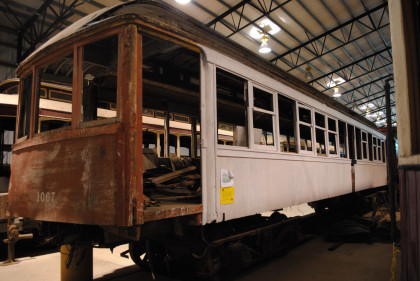
Portland Railway Light & Power wooden interurban 1067 built in 1907.
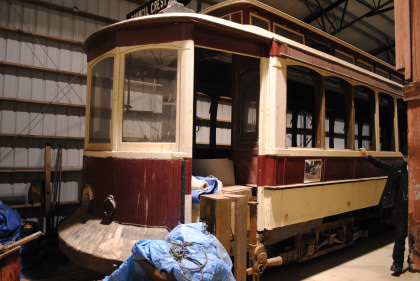
Council Crest Streetcar 506 built in 1904 by the J.G. Brill Company. This is the second of the two Council Crest cars owned by the museum. Unlike the operating 503, 506 still retains its narrow gauge running gear. It is also unique in that it has electric brakes instead of air brakes for it to negotiate the hilly terrain of its route. 506 will be preserved on its original running gear which means it will not operate at the museum unless narrow gauge track is laid.
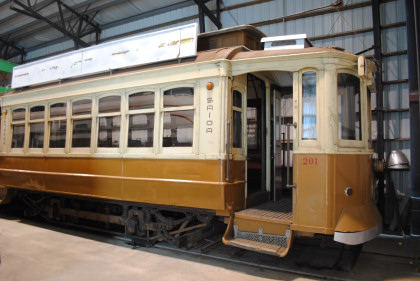
Oporto Railway car 210 built in 1909 by J.G. Brill and shipped to Porto, Portugal. It was rebuilt in 1940 and continued in service until 1994 then acquired by the museum in July 2006 and was shipped from Portugal to Port Elizabeth, New Jersey then trucked across the country.
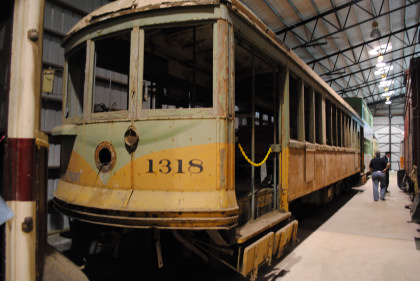
Los Angeles Railway narrow gauge streetcar 1318 built by the St. Louis Car Company in 1923.
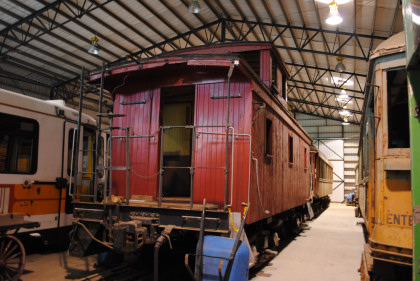
Spokane, Portland and Seattle Railway caboose 713 built in 1910 at Great Northern's McCloud, Minnesota shop using parts from a Great Northern four-wheel car.
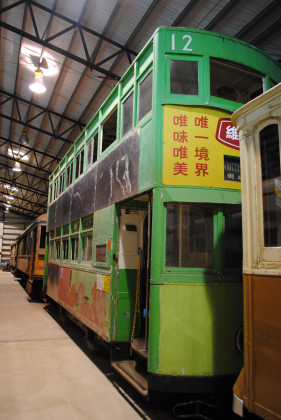
Hong Kong double-decker tram 12 which ran on Victoria Island in Hong Kong. Trams first operated in 1904 as single-deck trams and they quickly proved popular, so the system changed to double-decker trams for more capacity. Double-deck trams still operate in Hong Kong with very frequent service. This tram was brought over to Oregon by the late Bill Naito as a project to start a vintage trolley service in Portland's Old Town. The project eventually became Vintage Trolley and ran on the MAX lines for several years. Sadly #12 never operated, it had been stored in Montgomery Park.
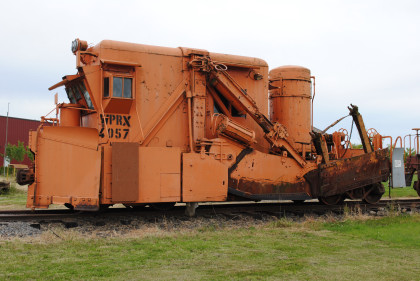
Southern Pacific Jordan Spreader 4057 built in 1925. Its last assignment for the Southern Pacific was working out of Ashland, Oregon on the Siskiyou Route, until it was retired and donated to the Pacific Northwest Chapter of the National Railway Historical Society. It currently carries the reporting marks of the Willamette and Pacific Railroad, as it was on loan to them for a time. Its last use was to clear debris from the Portland & Western Railroad's Astoria Line in 1999.
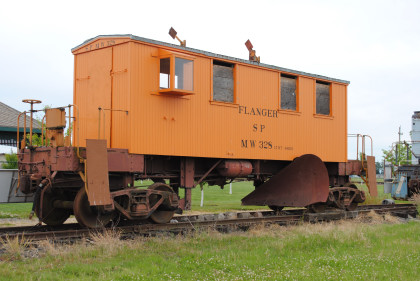
Southern Pacific flanger 328. Retired in 1981, it was donated to the Pacific Northwest Chapter of the National Railway Historical Society and may be the last wood- bodied flanger in existence.
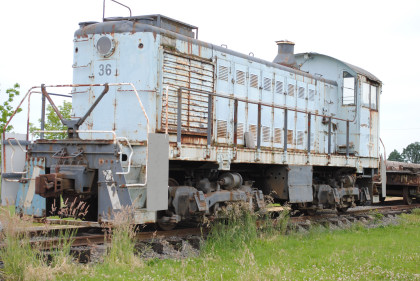
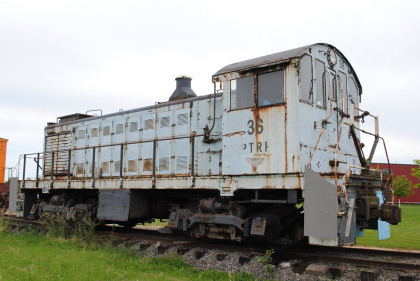
Portland Terminal S2 36 was built in 1943 for the Northern Pacific Terminal Company of Oregon, which became the Portland Terminal Railroad in 1965. It was donated to the Pacific Northwest Chapter NRHS in 1993.
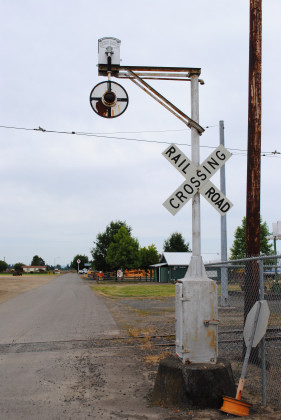
A rare wig-wag crossing signal.

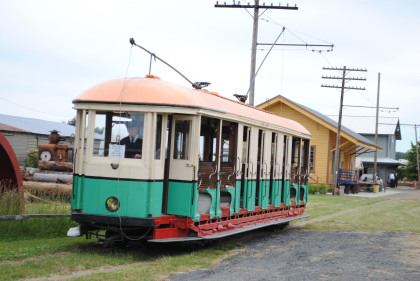
What goes around comes around. The Australian tram makes its way around the grounds on another run.
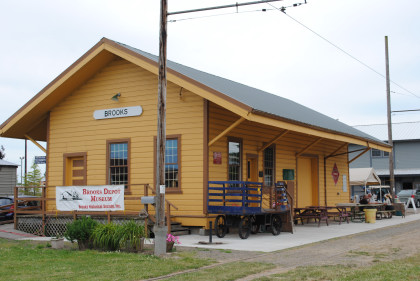
The 1887 Southern Pacific station at Brooks. After a most enjoyable visit, we drove Chris back to the airport but stopped at Elmer's Restaurant for a meal then drove back home to Lynnwood.
| RETURN TO THE MAIN PAGE |